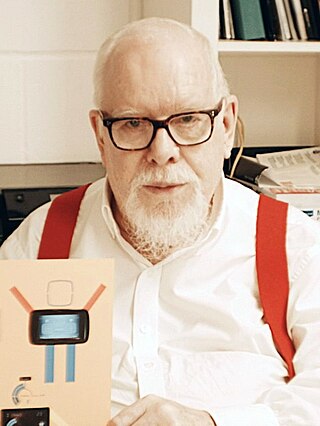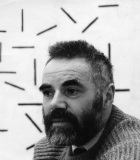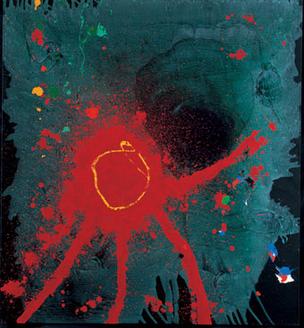Related Research Articles

John Constable was an English landscape painter in the Romantic tradition. Born in Suffolk, he is known principally for revolutionising the genre of landscape painting with his pictures of Dedham Vale, the area surrounding his home – now known as "Constable Country" – which he invested with an intensity of affection. "I should paint my own places best", he wrote to his friend John Fisher in 1821, "painting is but another word for feeling".

Sir Gordon Howard Eliott Hodgkin was a British painter and printmaker. His work is most often associated with abstraction.
John Walker is an English painter and printmaker. He has been called "one of the standout abstract painters of the last 50 years."

Patrick Joseph Caulfield,, was an English painter and printmaker known for his bold canvases, which often incorporated elements of photorealism within a pared-down scene. Examples of his work are Pottery and Still Life Ingredients.

Sir Peter Thomas Blake is an English pop artist. He co-created the sleeve design for the Beatles' 1967 album Sgt. Pepper's Lonely Hearts Club Band. His other works include the covers for two of The Who's albums, the cover of the Band Aid single "Do They Know It's Christmas?", and the Live Aid concert poster. Blake also designed the 2012 Brit Award statuette.

John Egerton Christmas Piper CH was an English painter, printmaker and designer of stained-glass windows and both opera and theatre sets. His work often focused on the British landscape, especially churches and monuments, and included tapestry designs, book jackets, screen prints, photography, fabrics and ceramics. He was educated at Epsom College and trained at the Richmond School of Art followed by the Royal College of Art in London. He turned from abstraction early in his career, concentrating on a more naturalistic but distinctive approach, but often worked in several different styles throughout his career.

Sir Stanley Spencer, CBE RA was an English painter. Shortly after leaving the Slade School of Art, Spencer became well known for his paintings depicting Biblical scenes occurring as if in Cookham, the small village beside the River Thames where he was born and spent much of his life. Spencer referred to Cookham as "a village in Heaven" and in his biblical scenes, fellow-villagers are shown as their Gospel counterparts. Spencer was skilled at organising multi-figure compositions such as in his large paintings for the Sandham Memorial Chapel and the Shipbuilding on the Clyde series, the former being a First World War memorial while the latter was a commission for the War Artists' Advisory Committee during the Second World War.

Ronald Brooks Kitaj was an American artist who spent much of his life in England.

Richard William Hamilton was an English painter and collage artist. His 1955 exhibition Man, Machine and Motion and his 1956 collage Just what is it that makes today's homes so different, so appealing?, produced for the This Is Tomorrow exhibition of the Independent Group in London, are considered by critics and historians to be among the earliest works of pop art. A major retrospective of his work was at Tate Modern in 2014.

Paul Nash was a British surrealist painter and war artist, as well as a photographer, writer and designer of applied art. Nash was among the most important landscape artists of the first half of the twentieth century. He played a key role in the development of Modernism in English art.

John Bellany was a Scottish painter.

Edwin John Victor Pasmore, CH, CBE was a British artist. He pioneered the development of abstract art in Britain in the 1940s and 1950s.

John Arthur Malcolm Aldridge was a British oil painter, draftsman, wallpaper designer, and art teacher in the United Kingdom. He was elected an Associate of the Royal Academy (ARA) in 1954 and a Royal Academician (RA) in 1963.
Sir Richard Sheridan Patrick Michael Aloysius Franklin Bowling(né Richard Sheridan Franklin Bowling; born 26 February 1934), known as Frank Bowling, is a British artist who was born in British Guiana. He is particularly renowned for his large-scale, abstract "Map" paintings, which relate to abstract expressionism, colour field painting and lyrical abstraction. Bowling has been described as "one of Britain’s greatest living abstract painters", as "one of the most distinguished black artists to emerge from post-war British art schools" and as a "modern master". British cultural critic and theorist Stuart Hall situates Bowling’s career within a first generation, or “wave” of post-war, Black-British art, one characterised by postwar politics and British decolonisation. He is the first black artist to be elected a member of the Royal Academy of Arts.

John Hoyland RA was a London-based British artist. He was one of the country's leading abstract painters.
Victor Arthur James Willing was a British painter, noted for his original nude studies. He was a friend and colleague of many notable artists, including Elisabeth Frink, Michael Andrews and Francis Bacon. He was married to Portuguese feminist artist Paula Rego.
John Cecil Stephenson was a British abstract artist and pioneer of Modernism.

Margaret Nairne Mellis was a Scottish artist, one of the early members and last survivors of the group of modernist artists that gathered in St Ives, in Cornwall, in the 1940s. She and her first husband, Adrian Stokes, played an important role in the rise of St Ives as a magnet for artists. She later married Francis Davison, also an artist, and became a mentor to the young Damien Hirst.
Frances Macdonald, was an English painter known for her panoramic scenes painted in Wales, the south of France and in London during World War II.
Alfred Cohen (1920-2001) was an American artist whose art was firmly rooted in the European tradition; he was inspired in particular by the commedia dell'arte; and by the colour and handling of the Post-Impressionists and Expressionists.
References
- ↑ "Obituary: Ian Stephenson". The Times. 5 October 2000. Retrieved 25 January 2011.[ dead link ]
- 1 2 3 4 Ian Stephenson Biography Archived 16 December 2010 at the Wayback Machine New Art Centre
- ↑ "Obituary: Noel Forster: Artist who believed that painting is the 'concretisation of light'". The Independent. 2 January 2008. Retrieved 25 January 2011.
- ↑ Ian Stephenson 1934 – 2000 Tate website
- ↑ The Tate Gallery 1974-6: Illustrated Catalogue of Acquisitions, London 1978
- ↑ Channeling American Abstraction, Karen Wilkin, Wall Street Journal. Retrieved 7 October 2010.
- ↑ NY Times, exhibition review. Retrieved 15 December 2010.
- ↑ Obituary: Ian Stephenson Nicholas Usherwood The Independent 11 September 2000